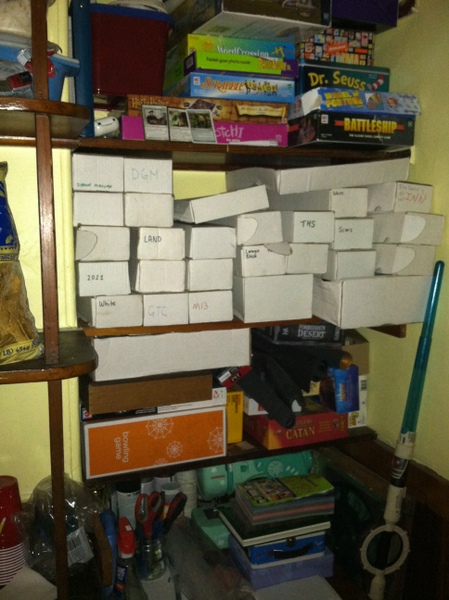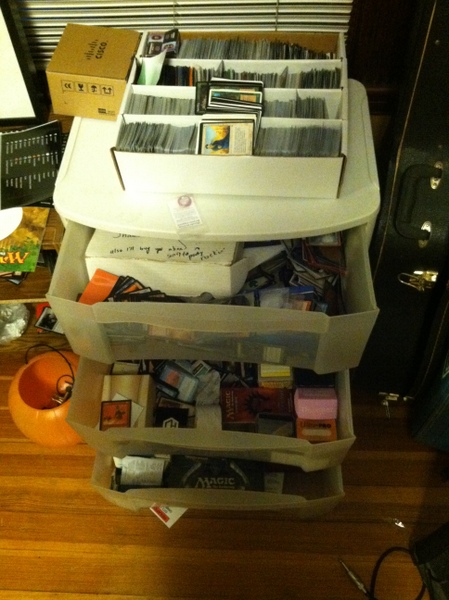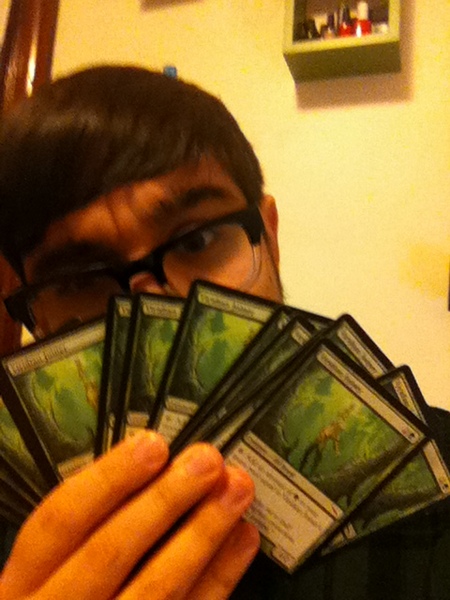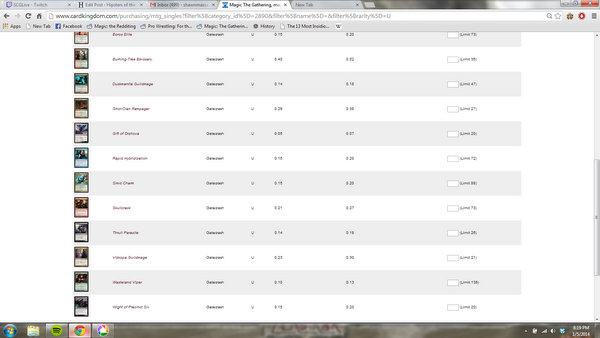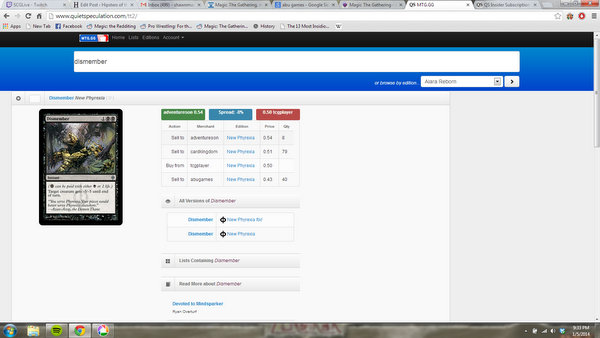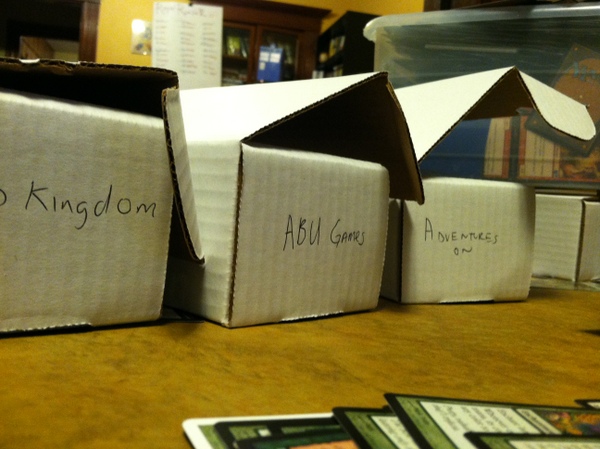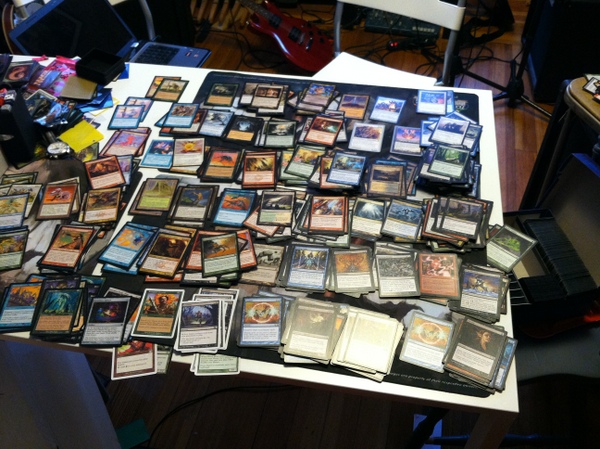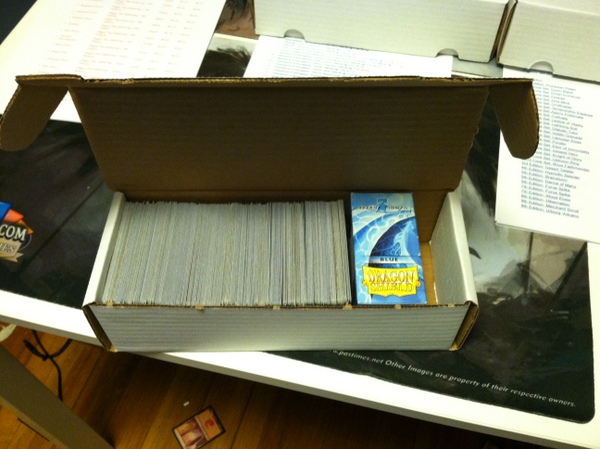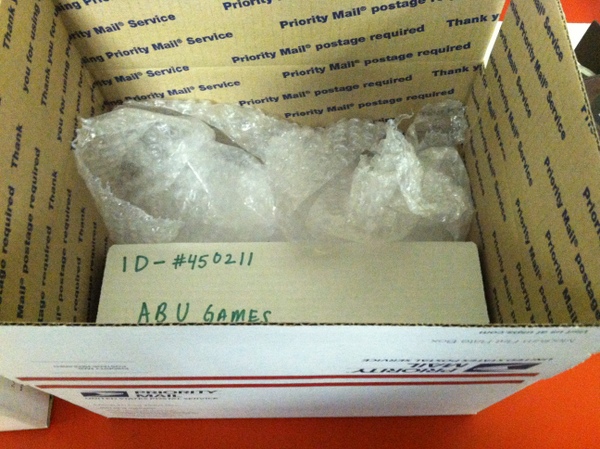I am haunted by Magic cards. They occupy every room of my apartment cluttered in boxes, sorted in stacks, and thrown in desk drawers. I have Magic cards on my windowsills, in the center console of my car, and in the space in the back of my guitar amp. Sometimes when I am trying to sleep, I hear cards beneath my pillowcase; crinkling, audibly bending and creasing. They are everywhere.
They aren’t the kinds of cards you want to find either. I never find an Underground Sea on my bookshelf. Well, unless you count a proxied Unified Strike with black Sharpie shorthand—”Underground.” No, I have seemingly millions of copies of Coral Merfolk (7th), several dozen playsets of Viridian Joiner, and a bunch of Japanese Pillar of Flames which have no monetary value since cycling out of Standard. I have somewhere in the neighborhood of 40,000 cards and would estimate that 37,000 are worth less than a nickle each, perhaps a few pennies each. These are the cards that haunt me and these are the cards I want to get rid of. These are the cards I want to sell to a buylist.
Since I work at a school, I recently had a few days off for the holidays. Much to the chagrin of my girlfriend, who was also on vacation, I designated a few days as “buylist time.” The thing is, buylisting a bunch of junk is really time-consuming and not especially profitable unless you reach a critical mass of junk. If you aren’t dedicated to the process, you aren’t making enough money to compensate your time and offset the cost of shipping. So if you’re going to do this, you need to set aside a full weekend to do so.
While I normally don’t write about this sort of thing, I wanted to write an article about buylisting in order to explain the complicated process, discuss possibilities during buylisting, and to write about the actual monetary value of completing this process. I think this is valuable to anyone who is considering buylisting or to those people who hadn’t considered that their closeted collection can be turned into money with some work. Without further ado, let me break down the process.
1. Set aside time to sell cards
The amount of time you need to set aside is of course contingent on how many cards you need to riffle through. In general, I like the idea of having two full days to search, sort, and sell. Even if you don’t get through everything you wanted to sell, 20+ hours of work should still yield enough card value to justify the process. Also, it’s better to keep the process within a two-day period since buylists are constantly changing and may not be buying the same cards tomorrow. For example, on Thursday, December 26th, Card Kingdom was buying 20 Viridan Joiners at .05 a piece. I happened to have 20 Viridian Joiners and set them aside. When I went to go through and actually put cards in my online selling cart, someone had beat me to it and sold Card Kingdom all the Joiners they needed.
2. Get a friend who knows Magic to help you out
Since buylisting a bunch of cards is time-intensive and boring, having a friend both expedites the process and makes it significantly less boring. My friend Rodrigo spent two nights on my couch, living off of Christmas leftovers, in order to help me separate cards, sort them, and type out their names onto buylists.
3. Set aside cards you think may be valuable
If you have as many cards as I do, it’s too time-consuming to individually price-check every card in your collection. Rodrigo and I ended up just putting aside cards that we thought websites could potentially be buying, i.e. commons and uncommons played in any format. The problem with this methodology is that many of the cards we put aside (30%) weren’t actually being bought and many cards we hadn’t thought to put aside were being bought. The best way I can figure to mitigate this problem is to look over some buylists, sorted by edition and rarity, and take notes. Sometimes the cards they are buying are surprising. If I were to go through my Gatecrash box, I wouldn’t necessarily think to put aside Thrull Parasite and Wight of Precinct Six but Card Kingdom is buying both at a pretty reasonable price:
4a. Use a buylisting tool to determine the best price for your cards
In the past I have exclusively sold cards to Card Kingdom as they offer a 30% trade-in bonus for people looking for store credit. This time, I wanted to consider selling to multiple sites to ensure that I got the best price on every card. I could also potentially sell cards that Card Kingdom wasn’t buying but another site was. In terms of buylisting tools available right now, there is MTG.GG and Bidwicket. MTG.GG is run by Quiet Speculation and requires a paid subscription to the website and Bidwicket is a free service. I believe MTG.GG is a better tool than Bidwicket, as it only lists reputable dealers (Card Kingdom, ABU, and AdventuresON) whereas Bidwicket lists a bunch of random TCGplayer stores. However, MTG.GG costs money to use as I mentioned earlier, $11.99 for a month subscription (this subscription also immediately renews at the end of the month, so you have to actually cancel the subscription before this happens) or $100+ a year.
Right now, our friends at CastHaven are developing a free buylisting tool on par with Quiet Spec’s, which I look forward to using for all future buylisting projects. And in a serious innovation—because most local game stores (LGSs) will pay *more* money for your cards than the big online retailers, plus you don’t have to worry about shipping—CastHaven’s tool also will allow you to buylist your cards to your LGS.
Anyway, a buylisting tool works by showing you what several stores are offering for a card. For example, I typed in Dismember into MTG.GG and the site responded with the buylist prices for several websites and how much you can buy one for on TCGplayer. By offering the TCGplayer price, you can avoid selling cards with a high spread, i.e. cards where the buylist price is significantly lower than the TCG selling price. What is interesting about the Dismember example here is that you can actually buy Dismembers from TCG and sell them to a buylist and theoretically make a profit. Buying cards from one site and selling them to another for more money is a principle called arbitrage but I don’t actually see it happen all that often. Here the possibility for arbitrage is actually pretty low because of the shipping costs involved in acquiring cards from TCG and then shipping them to another website. Still, though, it’s interesting to keep an eye out for any opportunity to make a quick buck, especially when it doesn’t happen all too often.
Anyway, I started going through the stacks of cards I had separated out, and then looked up every card in the stack on MTG.GG. From there, I would put the card in one of four boxes—Card Kingdom, ABU, AdventuresON, or junk-no-one-is-buying—depending on which site gave me the most money.
Going back to the Dismember example, it looks like I would most likely sell the card to AdventuresON, since they are paying the most for it. In this case, I actually sold the card to Card Kingdom, since they offer a 30% bonus on store credit payments, which means I actually sold the card for $0.66.
It is worth noting that after I had sorted cards into corresponding buylist boxes, I still had to go to each individual website and type in the cards I wanted to sell. By using a buylist management tool I was able to maximize my profits—but by doing so, I made additional work for myself. In my case it made sense to go through this additional step, though I could see someone short on time choosing one buylist and just trying to sell all their cards there.
4b. Use one online buylist and sell cards to one online dealer
Instead of using a buylist management tool, you could opt to just sell to one website. The upside of this is that you only have to pay once for shipping and it saves you a bit of time, as you are only typing in card names or entering values for one website. I’ve had really good luck with Card Kingdom in the past and would recommend selling to this site if you were going to pick one. In general, I find that Card Kingdom has the best prices on singles, offers the largest credit bonus, and has a very fast turnaround time between receiving your cards, grading them, and giving you money.
5. Alphabetize cards by set and enter cards individually on the buylist
Before you even start adding cards to your buylist cart, you should seperate them by edition and then alphabetically within those sorted piles. Every buylist website I have encountered wants it done this way and will often penalize you if the cards are not sorted in this order. From there you want to go edition to edition, alphabetically, and start entering cards. If I was on Card Kingdom, I would start with 3rd edition and then either type in the name of the cards I wanted to sell from 3rd edition, or open the 3rd edition tab and go through marking the quantity of cards I wanted to sell. Then you put those cards in the box and go to the next set until you’ve gone through them all. After entering all the cards you had to sell, you’ll get a finalized list of the order the cards should be in and a total of how much money you made. This total isn’t actually what you’ll be making unless all cards are mint or near mint, which for me is never the case. In general, I expect to lose maybe 10-15% of the value due to cards being in excellent (EX) or lower condition.
6. Pack up your cards
I like using the 500-count cardboard boxes for mailing out cards. I’m sure that you could MacGyver a cereal box to adequately store your cards but I like to err on the side of caution and spend the $1.50 to get a sturdy box made to store trading cards. If you’re using buylists to sell just a handful of cards, I think you’re doing it wrong, but you can get a plastic-hinge case and mail it in a padded envelope.
7. Mail your cards
Websites that offer a buylist make you pay for your own postage. While postage does depend on weight, I usually just purchase a flat-rate Priority Mail box and send it that way. For larger orders, I’ve found the flat-rate boxes are about the same, or cheaper, than using regular first-class mail. Furthermore, by using Priority Mail, it gets there faster with tracking information to boot. The 500-count boxes I use fit into the medium-sized flat-rate box which is $12.35. When you send the box, make sure you have a print-out of the invoice and the order number somewhere on the box. By providing this information, you’re reducing the chance that something gets mixed up or misplaced.
8. Wait for your stuff to be graded
After you’ve mailed everything out, you basically just wait until they have processed your cards and given you the money. Like I said previously, I have always received less money than initially quoted because I included cards that were not near mint, and they give you less money for those. Usually this process takes a week or two, which is understandable considering the volume of cards coming and going from these online stores.
The Numbers
I thought I would crunch some numbers to give you an idea of how profitable—or not profitable—it is to ogre through your cards and buylist commons/uncommons and bulk rares.
AdventuresON—$83.41 (Cash)
ABU Games—$87.69 (Credit after 25% bonus)
Card Kingdom—$139.89 (Credit after 30% bonus)
TOTAL—$310.99 (Before grading)
Expenses:
Three 500-count boxes—$4.50
Shipping and bubble wrap—$40.70
Six-pack of beer (payment for Rodrigo)—$12.00
One month account to MTG.GG—$11.99
TOTAL—$69.19
I ended up netting $241.80. The whole process took roughly 22 hours. If I were to calculate my wages, I made $11 an hour. Keep in mind that this figure should be less because of grading and because I’m not a completely horrible friend and I’m going to get Rodrigo something for his troubles.
Ultimately, it would have been more profitable for me to just pick up an extra shift or two at work. Yet, at the same time, if I was at work, I wouldn’t be hanging out with my friend in my living room looking at Magic cards, so there’s that. This process was definitely arduous but only in a first-world sense of the word. I basically got to upgrade a bunch of junk into Legacy staples just by putting in a some effort. I hesitate to recommend anything where companies profit off your labor and your goods, but I honestly don’t have a use for nine Ichor Wellsprings and don’t mind selling them for three cents each. So yeah, if you have a lot of junk and a little bit of time, go ahead and make a little bit of money.
I hope you guys didn’t mind this departure from my normal column. Next week I’ll be back playing Standard with whatever 75 cards I can get my hands on in the next few days.
At age 15, while standing in a record store with his high school bandmates, Shawn Massak made the uncool decision to spend the last of his money on a 7th edition starter deck (the one with foil Thorn Elemental). Since that fateful day 11 years ago, Shawn has decorated rooms of his apartment with MTG posters, cosplayed as Jace, the Mindsculptor at PAX, and competes with LSV for the record of most islands played (lifetime). When he’s not playing Magic, Shawn works as a job coach for people with disabilities, plays guitar in an indie-pop band, and keeps a blog about pro-wrestling.

